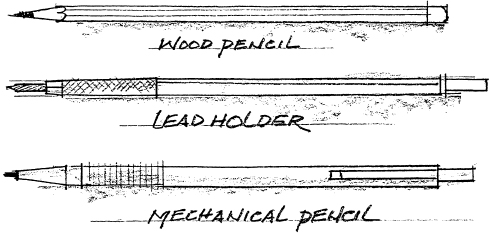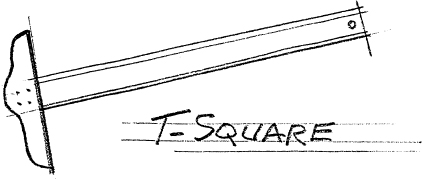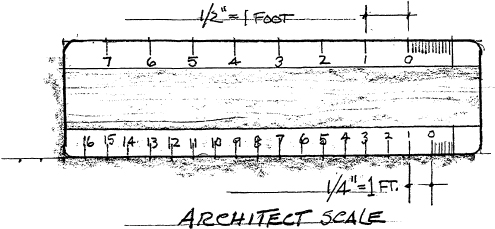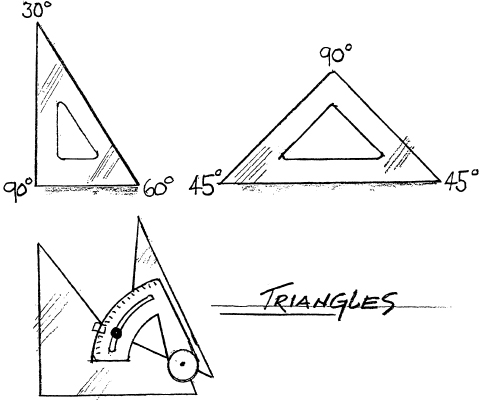TOOLS FOR CONSTRUCTION DRAWINGS
The producer and director think your sketches are inspired and have told you to go ahead with the pilot project. What now? Do you just take the sketches to the construction shop and tell them to build it? No. Building from sketches is an emergency measure when time is short and experienced set builders can tackle the job.
We are not going to work that way—taking what seems to be the easy way out. We are going to do it the right way by making construction drawings for bids. For this stage, you will need some more aids – more pencils, a T-square, an architect’s scale, and triangles.
A drawing board should be flat, have perfectly straight edges, and possess corners that form 90° angles. Get the largest size board you can accommodate. Boards smaller than 24" x 30" are not useful for making construction drawings. Boards 30" x 40" or larger serve most purposes. A table and a couple of blocks to prop up your board work, but if you want to spend more money, get a board with legs or a pedestal. Make sure the board doesn’t shake when leaned on.
Be kind to that piece of wood. Remember that dents or holes will make dents and holes in your drawings when your pencil passes over the tracing paper. Art supply stores sell many types of cover materials to protect the wood’s surface. Once again, don’t use pushpins to fasten your drawings. Later, as projects roll in, you may want to invest in a drafting table with an adjustable, slanted surface.
Remember, we said earlier that tracing paper by the roll is the best way to go. Buy good quality paper for finished construction drawings, but you can use less-expensive paper for preliminary drawings unless you expect to do a lot of erasing. Art supply stores sell tracing sheets with printed borders and title blocks. These sheets cost more and look impressive, but force you to work within the border confines, unlike roll tracing paper which lets you draw your own borders and title blocks.

Another type of tracing paper has a ⅛" or ¼" grid printed in light blue that does not reproduce in the blueprint process; the grid is useful as a guide when your T-square, architect scale, and triangles are not available.
If you use ink, fiber-tipped, or ballpoint pens to make construction drawings, erasing is impossible. The following are three common types of pencils and lead holders.
1. Wood-bodied lead pencils are the cheapest, but require constant sharpening and replacement. A pencil extender can squeeze the last bit of use out of a short pencil. Hand-crank and electric sharpeners, knives, and sandpaper blocks work on this pencil.
2. Metal lead-holders use the same lead thicknesses as the wood type, but need only replacement of the lead in the holder. Sharpen these leads with a sandpaper block, knife, or drafting lead pointer.
3. Mechanical pencils commonly use 0.5 or 0.7 millimeter leads which remain the same width and renew themselves by a push on the top of the pencil; no sharpener needed. Each lead thickness requires its own holder.
Choose whichever type of pencil seems right for you. Start with two lead hardnesses: 2H for heavy lines, and 4H for the light lines. Everyone has favorites. Retired art directors rocking on the porch at The Home for Old Art Directors while away many hours arguing the pros and cons of the lead pencil, lead holder, and mechanical pencil. Some like to use only one lead hardness, and, by bearing down with various pressures, make different line weights. Others argue for many pencils holding several lead types.
Erasers such as the Pink Pearl™ work fine for eliminating sketch and construction-drawing pencil lines. If you plan to do a lot of erasing and hate to throw a drawing in the wastebasket, invest in an electric eraser. This device will make everyone think you are an experienced pro or wonder if you make a lot of mistakes.
T-squares are guides for drawing smooth horizontal lines and serve as plastic triangle bases for vertical lines or lines at angles. For construction drawing, a plain wood T-square with transparent plastic edges works well.
Get a square the length of the long edge of your drawing board. Buy the best quality you can afford, but avoid fancy versions. They can look great, but may not perform as well as the standard model with an AM radio and blackwall tires.
People who do a lot of drafting frequently use a drafting machine, which combines the functions of a T-square, triangles, and architect’s scale. This machine does not do the drafting for you, but is an arrangement of counterbalanced metal rods arranged like a human arm. The pivoted top clamps to the drawing board top and the head features a knurled knob, which controls two transparent architect’s scales at right angles to each other. The knob can turn the scales to any angle, which eliminates the need for the T-square and an array of plastic triangles. Spring tension holds the scales at any position on the drawing board, even when the board is in a near vertical position.

Don’t do any of the following:
• Use it for a hammer
• Cut along its edges
• Allow it to fall on its head
• Let it get wet
• Leave it in the sun
• Let kids play with it
• Loan it to anyone
If we were to make drawings in a 1’ to 1’ scale, our drawings would be as large as the set itself, so someone invented the architect’s scale. With this scale, you can convert full-size foot-and-inch measurements into smaller units that represent feet and inches. Be sure to get an architect’s scale; not an engineer’s scale which uses a different system. Scales come in different shapes and sizes. The triangular style has two scale systems on each of its three edges. Flat scales have two systems on each of their two edges, and come in short and long sizes. The short model is easy to carry and looks very professional sticking out of your pocket, but the longer sizes are better for drafting board use. Most construction drawings for film and video use ¼" equals 1’ and ½" equals 1’ scale.


The same don’ts apply to architect’s scales as those listed for T-squares, plus don’t draw lines against the edges. This bad practice can spoil the accuracy of the tiny marks. Above all, don’t hurl the scale across the room when things go wrong.
These useful pieces of transparent plastic have three perfectly straight edges placed at different angles to each other. When a triangle is placed on your paper with one edge snugged against the T-square, edge, you can draw vertical lines and lines at angles. A 30-60-90-degree triangle has three corners available for drawing those angles. The same system applies to a 45-45-90-degree triangle. An adjustable triangle allows you to draw any angle.
You need a place to work. This does not mean that you need a big studio with skylights. Dream about that for the future. The corner of a room with a drawing board, stool, lamp, and a small chest of drawers in which to keep the stuff we’ve been talking about works well.
If you have not splurged on a pedestal or legged drawing board, be creative. Support your board at an angle on a table; use stacked boxes for storage; and fasten a piece of soft composition board to the wall for pinning up drawings and ideas. Pushpins work well here, but not on your drawing board.
A basic computer-aided drafting (CAD) system requires a powerful computer with plenty of memory and hard disk space, CAD software, and a plotter that can make large prints.
Some studios that produce daily shows such as daytime dramas and game shows, have found the CAD system useful, because it allows rapid day-to-day set drawing changes without hand redrafting or using overlays to make prints. However, designers familiar with the CAD system have to make the changes.
If you want to consider buying a system, find someone who uses one on a daily basis, and see what they have to say about its practicality for individual designers.
•
With sketches and basic tools at hand, let’s go on to the next chapter and begin the construction drawings.
